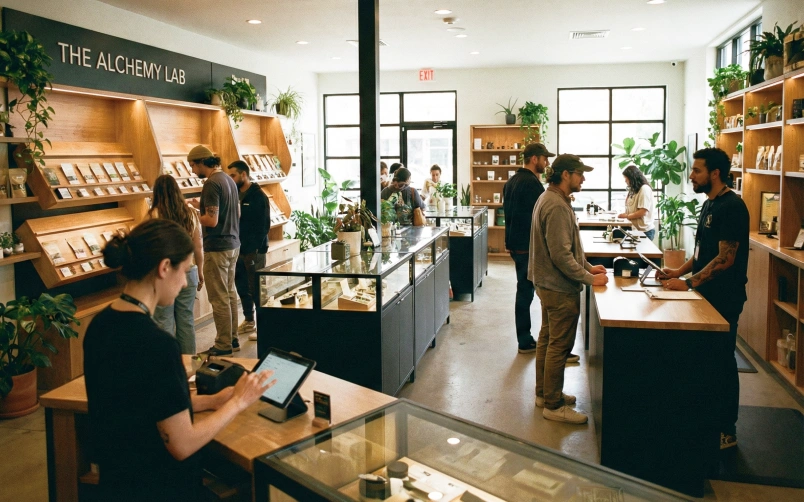5 People Management Tips For Multi-Location Dispensaries

The cannabis dispensary ecosystem is truly unique. While many cannabis businesses are small local operations, a growing number are multi-location chains. Some dispensaries have taken on the role of both grower and supplier, controlling the process from seed to sale.
With so many different types of operations under one umbrella, it can be difficult for owners and managers to know how to approach each aspect of their business. People management can prove challenging, requiring an entirely different approach in multi-location dispensaries than single-location stores.
Today's article will outline five tips for managing your people when running a multi-location dispensary. We hope they'll help you keep things running when working multiple store locations at once.
What is a multi-location dispensary?
A multi-location dispensary has more than one location. They may be located in the same city or different cities. What makes a multi-location dispensary different from a single-location cannabis dispensary is the same thing separating a small business from a big business—scale.
Multi-location dispensaries have more employees, more customers, and more products to deal with. All this calls for better systems and processes, an increasingly sophisticated understanding of marketing, and a more significant investment in technology for things like inventory management and POS software.
Multi-location dispensaries are part of what makes the cannabis industry so exciting. The country is changing rapidly as the plant is legalized across the United States, and now that it's legal in some form in 33 states (and counting), there are new opportunities every day to expand and grow your business.
Here are five people management tips to help you get your multi-location dispensary off the ground:
1 - Get a bird's-eye view.
One of the most significant differences between managing a multi-location dispensary and a single location dispensary is that you are now responsible for the entire operation and not just the one store.
Review all stores from one platform to see everything happening at once. You can't run around from location to location, making sure that each store does what they have been assigned. It will take up most of your time, and you won't be able to focus on other aspects of your business.
Fortunately, with the help of technology, it is now possible for management to oversee all available data from one place. The technology will help keep things moving fast at each of your locations.
Comparing data from different stores will also help you make informed decisions about how each store is performing and how they can improve on their weaknesses. For example, if one store is consistently underperforming another, adjusting staffing levels or making operational changes at that particular location might be necessary.
.jpg)
2 - Don't double book your staff.
One of the biggest mistakes that cannabis dispensaries make is double booking their staff. It occurs in various ways—maybe you forgot that an employee already had a shift scheduled at another location, or perhaps someone was supposed to come in but called in sick at the last minute. Whatever the case may be, if one of your employees is overbooked for the day, someone else needs to cover for them, and it can become quite a headache for everyone involved.
When your dispensary has multiple locations, it's essential to have a scheduling tool that works across the board. You want to be able to schedule staff members for one dispensary or another and view their availability without having to guess what your employee is doing at any given time.
By having the right scheduling software in place, you can ultimately eliminate the issue of double-booking an employee and ensure that the right people are working at each location when needed.
Additionally, you need to be aware of how long each of your staff members is spending on the clock so as not to overwork them and end up paying overtime. Make sure you're using a scheduling tool to calculate an employee's hours worked automatically. It will save you from paying unnecessary overtime, help prevent double booking, and keep everyone happy.
3 - Don't let bad apples return.
You may not be able to prevent every bad apple from entering your ranks—but there are ways to make sure bad apples don't do any more harm. Your employees are your most valuable asset. But sometimes, as unfortunate as it may be, they can also be your biggest problem. When you have multiple locations, this is amplified because you don't want an employee who has been fired at one site to come back to haunt you at another one.
To prevent this from happening, set up your system so that all employee data is centrally stored and accessible by every branch manager. The system will allow you to make informed decisions about hiring and firing within your organization.
It's also good practice to use this centralized database to monitor your entire staff and gauge their performance against one another. If someone falls below a certain productivity threshold, it might be time for a disciplinary conversation or dismissal.
Having all of your employee data in one place allows you to handle personnel issues quickly and efficiently while supporting your business.
4 - Automate approvals and free up six figures.
As a multi-location dispensary owner, you know that time is money. But did you know that your time approval system could be costing you millions per year in wasted labor hours?
If your managers are responsible for processing, approving, and paying all their employees' payroll, they spend at least one hour per week on the task. If they're managing 100 employees, they're spending 100 hours per year on payroll approval—and that's just doing the math.
In reality, it's even worse. Manually tracking and approving employee time is a costly headache. And, while most dispensary owners don't have a problem paying employees overtime when times get busy, they may not realize how much paying for unapproved overtime is eating into their profits.
For example, say you run ten dispensary locations, each with ten employees, and each employee is punching in 5 minutes early and out 5 minutes late (10 minutes).
That results into the following mind blowing equation:
10 locations, 10 employees, 10 minutes.
10 X 10 X 10 = 1,000 minutes of unworked paid time.
Or 1,000/60 = 16.70 hours of unpaid work.
If your employees are getting paid $20 an hour, that's $333.34 each day.
16.7 X $20 = $333.34
Now imagine this has been going on for a year.
$333.34 X 365 = $121,669.10 on unworked hours each year.
Using a time clock that integrates with your scheduling system can help you avoid letting employees clock themselves in before or after their shift ends.
You can automatically enforce early clock-ins or late clock-outs to prevent unauthorized overtime from happening in the first place. And if an employee does work extra hours beyond what's been approved for their schedule, you can easily see which manager approved the exception so you can follow up as necessary.
Additionally, implementing facial recognition time tracking will ensure that your managers are where they should be. It also helps track who is on shift at any given time, knowing if three people were working during a rush or if only two scheduled employees showed up.
In the event of a robbery, you have a record to check. This could save you from paying for any stolen merchandise if the employee responsible is caught. It also helps ensure that no unauthorized people enter the dispensary. By using facial recognition time tracking, you're sure that only approved employees are entering, and buddy punching won't happen!
.jpg)
5 - You can automate your payroll process.
Payroll is a great place to start your automation journey because it can often be time-consuming and costly. The more locations you have, the more complex it gets to keep track of payroll records and ensure that you pay your employees promptly and accurately. There are several ways to automate your payroll and streamline this process, allowing you to get back to running your business.
Integrating time clock software into an online payroll system allows you to track employee hours by location in each dispensary. When an employee clocks in or out, the software transmits that information to the cloud for real-time updates
Each day, when you're ready to process payroll, log into the system and approve clocked hours by location. Once approved, the software will calculate all necessary payments like overtime or holiday pay and automatically remit them as direct deposits to each employee's bank account.
Here are other benefits of automating your payroll:
- Payroll automation saves you time. There are only 24 hours in a day, and payroll automation can save you time. Instead of calculating employees' hours and printing reports, you can have it all done automatically. Avoid extra fees if a check gets lost.
- Automation saves you money. There are many ways that payroll automation saves you money, but one of the most obvious is labor costs. The less time you or your employees spend on payroll processing, the better it is for your business. Not only do you save money on labor, but also the cost of paper checks. Plus, with the savings from payroll automation, you can hire more employees for other roles in your business—or pay those employees more!
- It reduces errors and mistakes. Humans are fallible—we all make errors from time to time, and that's true for all professions, including HR professionals and payroll specialists. However, with automated systems in place, you reduce the chances of data entry errors and miscalculations, so everyone receives their correct wages every single time.
- It boosts productivity. Automated payroll systems improve the efficiency of your workflow by freeing up valuable time for your HR team to focus on more important things like recruiting and employee retention. This solution also gives you more control over the process, and helps you know what's going on.
- It provides you with critical information for strategic planning and budgeting. When you automate your payroll, you have access to all the data related to your business's finances. The primary data is beneficial for strategic planning and budgeting purposes. You can also make adjustments based on fluctuations in demand or supply due to changes in local regulations or other factors affecting sales numbers at each location.
.jpg)
You can also use the automated and integrated payroll software for calculating tax deductions and remitting them directly to the CRA—you don't even need to worry about spending time on government forms or keeping track of multiple employee tax files. Make sure any system you invest in has user access controls so only authorized personnel can manage your payroll records. The best part is that most automated payroll systems are easy to set up on your own—no need for an accountant or other expensive professional!
What is key for multi-location dispensaries?
It's important to remember that automation is at the heart of every successful multi-location dispensary management system. A well-integrated central system can streamline payroll, inventory and financials. Businesses can predict trends and make informed decisions that improve efficiency by gathering data over time.
Tech companies like Kayapush are taking it upon themselves to continue evolving new technology that makes management of multiple locations a breeze. They can handle anything from employee screening, HR, payroll, and employee management in an easy all-in-one platform. With this solution in place, you can feel confident that each location gets the support and resources to run smoothly.
Hiring budtenders for your multi-location dispensary? Get the free budtender onboarding checklist here!



